Traveling with Grace: Exploring Istanbul
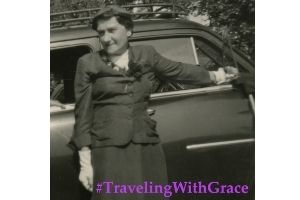
This week Grace’s diary catalogs her visit to Istanbul. Special thanks go to JMM volunteer Harold Toppall for his transcriptions of Grace’s travel diary. As mentioned previously, Grace’s language and word choices are not always progressive – this entry in particularly contains an insensitive reference to the Roma people.
Monday, May 17, 1953
On our tour of the city (Pera & Galata) this morning with Mr. Fahri we saw as follows: a large stadium where soccer is in progress – a huge crowd so must be popular sport here; a visiting circus in the most garish looking tent, which reminded me of a dime novel edition of the Arabian Nights, the beautiful Istanbul University, coed since 1946; the new Hilton Hotel under construction & still far from completed tho they expect it opened by Sept.; fine shopping section with displays equal to 5th Ave. tho the st. is narrow;. the Sublime Porte where the Sultan had a diplomatic school for his emissaries whence he sent them to the various countries; a beautiful red marble & bronze monument to Ataturk with many figures in high relief with Ataturk in the forefront; everywhere one sees porters running with enormous loads on their backs (they carry up to 400 lbs I’m told, & are almost bent double; in the bake shops are displayed curious round loaves about the size of matzos these especially for the Feast of Ramadan; cemeteries with tomb stones that look hundreds of years old, the men’s surmounted by some turbans & fezzes, the women’s plain shafts or obelisks & some have photographs on them but these are new ones.
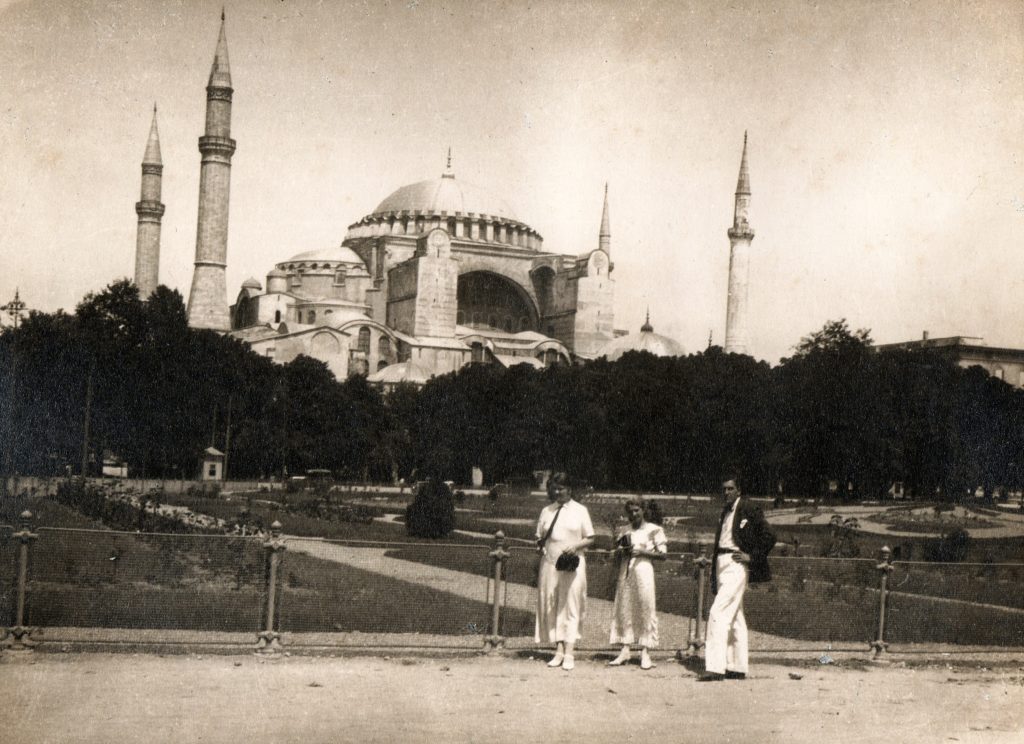
We went into the Mosque of St. Sophia, the largest, now a museum tho it has at various times been Christian Church (built by Constantine in 1456) & Mohamedan mosque when all the Christian figures on the frescoes were painted over but Ataturk had it restored & made a museum. In it are huge columns of granite, wonderful hanging chandeliers originally burning oil but now electrified, magnificent mosaics in the vault & arches, frescoes of the Virgin and child, a huge gold lined dome, rich carvings wrought iron gates, the Sultan’s priestly box & entrance hidden behind elaborate fretwork of stone, a high cone-shaped pulpit where the muezzin translated the Koran to the people, rich prayer rugs on the floor; a latticed stone gallery for the women; in a stone column there is a hole said to have been made in it when a holy man once touched it since which time people have been sticking in the index finger of their right hand to make a wish; the mosque took 16 years & 4,000 workmen to build.

We then went over to the Mosque of Suleiman the Magnificent about noontime & saw the men washing their hands, feet & faces at outside washstands before entering to pray & we saw the muezzin climb to the top of one minaret (there are 7 to this mosque) & heard him call the faithful to pray. It sounded like a chaz was chanting. We paused for a while on a hill overlooking the Bosphorus & the Sea of Marmara & in the distance we saw the hospitals erected with the help of the British after the Crimean war & the first school for nurses begun by Florence Nightingale. We visited the Hippodrome built by Constantine where the horses used to run & in the middle are 3 interesting columns, the Serpentine (columns of Delphi) one of bronze partly demolished, the columns of Theodosius once covered by bronze plaques but now left bare to its brick lining, & the beautiful Constantine column covered with Egyptian hieroglyphics, nearby is a modern monument which the last Sultan erected in honor of Kaiser Willhelm the II when he came here 1898 to open the railroad station for the Simplon Oriental Express.

We then went to the main bazaar of Istanbul – 92 streets. in it – & I really surprised myself at being able to walk thru several of these hilly narrow, crowded, cobbled streets. Each one is devoted to a certain merchandise, i.e. street of shoes, of cloth, of rugs, brass, of wood furniture, of straw, of jewelry, etc. In the latter street I entered the shop of a Mr. Moses, a fine Turkish Jew who welcomed us courteously & showed us jewels worth a king’s ransom some of which had belonged to Czars & Emperors. He said here jewels are considered a safe investment. He took special pieces out of a safe to show us (knowing as he did that we had not come to buy) & when he heard I had been to Israel he questioned me with great interest about it.
We returned to lunch at the hotel & afterward visited the Jewish quarter where they opened a lovely little synagogue for me to see & I met the young rabbi. The ark contained a rich collection of Torah cases. We then went to the old palace of the sultans, visited the 5 gardens one filled with tulips. After we heard the history of same, saw the harems, & the fabulous porcelain collection which was simply breathtaking & defies description. Sufficient to say that every country in Europe is represented by its finest examples & the whole represents the combined collections of 37 sultans, easily the largest finest in the world. Also, a vast silver collection just as impressive (I must mention huge silver bird cages) also a gold replica of the Chinese royal palace with jeweled flowers & birds in a hanging garden. Then we saw the sultan’s kitchen where food was prepared for thousands & the size of the copper & brass pots, pans & other utensils is in accordance. Everything is gargantuan in size & splendor. Unfortunately the Treasury of precious gems is closed today, but I doubt I would have had the strength physical or mental to do more today.
Tuesday, May 18, 1953
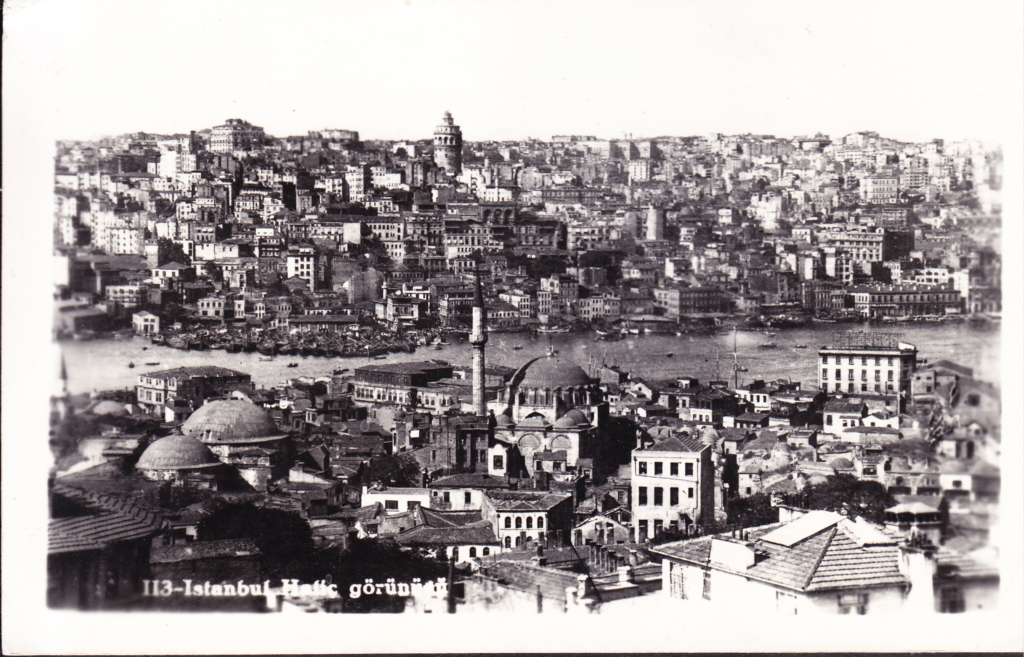
Started out with guide (he took his 4 yr. old son Mustapha along, a darling well-behaved child who kissed my hand when we parted) about 10:30 for a beautiful ride along the Bosphorus to the point where it meets the Black sea. We passed thru many towns & villages, the names utterly indecipherable to me – I can really understand now how it feels to be illiterate – past beautiful summer villas – most of the countries have their summer embassies along this road and wisteria just spills over everything – their flowers come in bloom much later than ours – past fishing fleets. Some of them are drying their nets having brought in their catch of sardines which we see them stringing in bunches of about a dozen. These they hang up to dry & we see such bunches hanging in the windows & doorways of many shops.
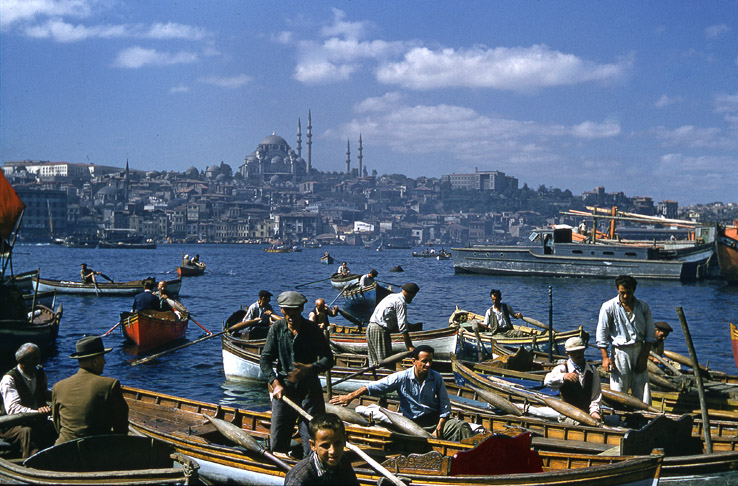
The little children coming home from school all wear black slips over their other clothes, boys & girls alike except that the girls have white collars. We saw Robert College & the American College for girls. We stopped at a delightful place called Sariyer & ate our lunch leisurely in an airy pavilion overhanging the water of the Bosphorus, where a large excursion boat stops at intervals to take on & discharge passengers. We drank the national drink (very strong & we had to dilute it with water) the name of which sounds like “Lucky” but I couldn’t quite make out how they spell it, but it made me feel jolly. We had delicious fresh sardines, olives, onions, a native dish made of rise wrapped in grape leave & cooked in olive oil, a Russian salad of eggs & vegetable served in a mold, & peach compost.
Later we returned by a different route over some low mts. & pretty open country. We passed a cavalry army school & a Squibbs factory. Also a settlement of gypsies, who look & live the same everywhere. Back in town we returned to the Grand bazaar as I wanted to buy a rug but they are prevented by law to ship them out of the country & I was unwilling to drag it around with me, so we remained at an impasse, tho I saw some beauties & they were quite reasonable.
![Black and white photo postcard showing a bridge full of cars, trucks, trolleys and people on foot. A large city can be seen in the background. Text on image reads "Istanbul, Golota Koprusu" [German].](https://jewishmuseummd.org/wp-content/uploads/2020/12/Istanbul-1953-german-1024x642.jpg)
Tonight Mr. Fahri called for us at 8 o’clock & we rode around for a while seeing the city decked out in lights & this for Ramadan which last 20 days. We went to a restaurant garden in which the trees had large green lights shaped like lollipops hidden in their branches, but they were not serving here tonight so we went on to another called the Lido where we had a very nice meal. I ate a sort of cream soup made with eggs & croutons on top which Mr. Fahrie called a wedding soup. We sat by a window overlooking the Bosphorus & the boats came so near we thought we could touch them. The full moon cut a wide swath of silver across the water & the scene is very like Venice. There is music & dancing too.
Wednesday, May 19, 1953
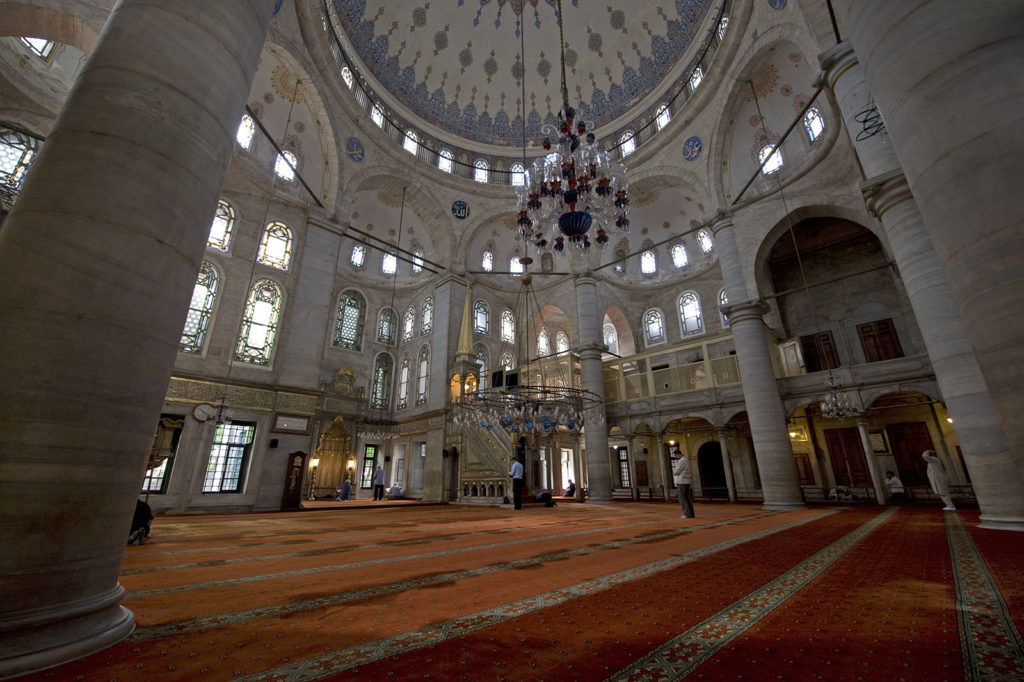
This morning we rode over to the sacred mosque of Eyoub (sacred because here is buried the secretary of Mohamed a holy man & the people pray here before going to Mecca. As today is a holiday there are crowds here. Pigeons are flying all over the place & people are feeding them corn. The men are washing their feet, hands & faces at little pumps all around the outside of the mosque. In the courtyard we saw a big crowd gathered in front of a large old tree. We approached to see what they were looking at & saw a stork which had its nest in the hollow of the tree. Perhaps the bird too is sacred, I couldn’t determine.
Close by we looked up to the top of a hill where we saw a large old red house overlooking the Golden Horn. Here dwelt Pierre Loti once upon a time. Mr. Fahri said many people used to visit it but few go there now. It looks quite deserted. Some of the streets we rode thru in this section are incredibly hilly and & winding, the houses nearly all of wood, an ugly gray tone & innocent of any vestige of paint tho some of them have beautiful, embroidered curtains upstairs & the lower parts have queer latticed wooden blinds in front of doors & windows, a hangover from the days of woman’s seclusion. Even now we remark the preponderance of men over women in the streets & public places. In the restaurants the men outnumber the women by at least 10 to 1.
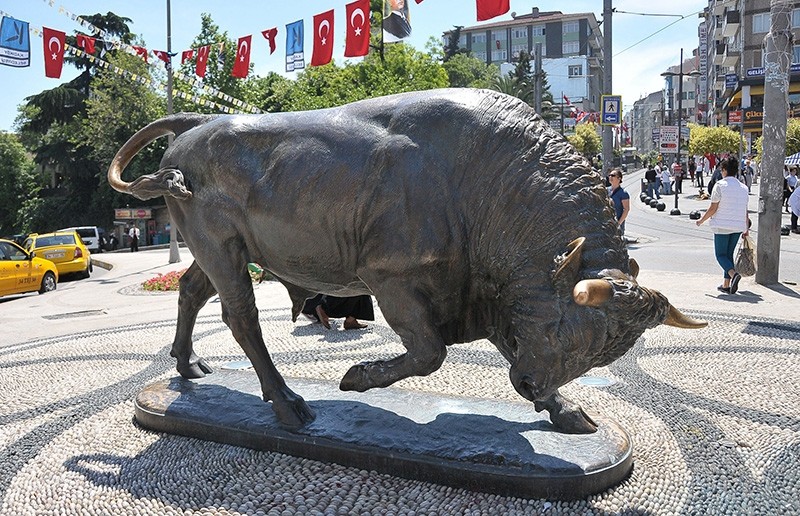
We had a nice ride out in the country where we saw small farms & huge herds of goats & sheep, the latter yellowish in color with a red mark on their backs to denote ownership. Back in town we saw the sports palace with a huge bronze figure of a charging bull in front of it. The school & hospital bldgs. are really very nice. We have our lunch at the Abdula restaurant which Mr. Fahri says is one of the best, very nice.
After lunch we crossed the Bosphorus on a ferry to the Asia side (Scutari) & rode to the top of a high mt. (7500 ft. above sea level) where we enjoyed a glorious view over all Istanbul to the Dardanelles & Princess Island (Princess is the biggest). On the way up we went thru the Jewish quarter & saw an old Jewish cemetery. I could see the Hebrew writing on the tombstones, in a sad state of decay & neglect. Mr. Fahri said it is no longer used.
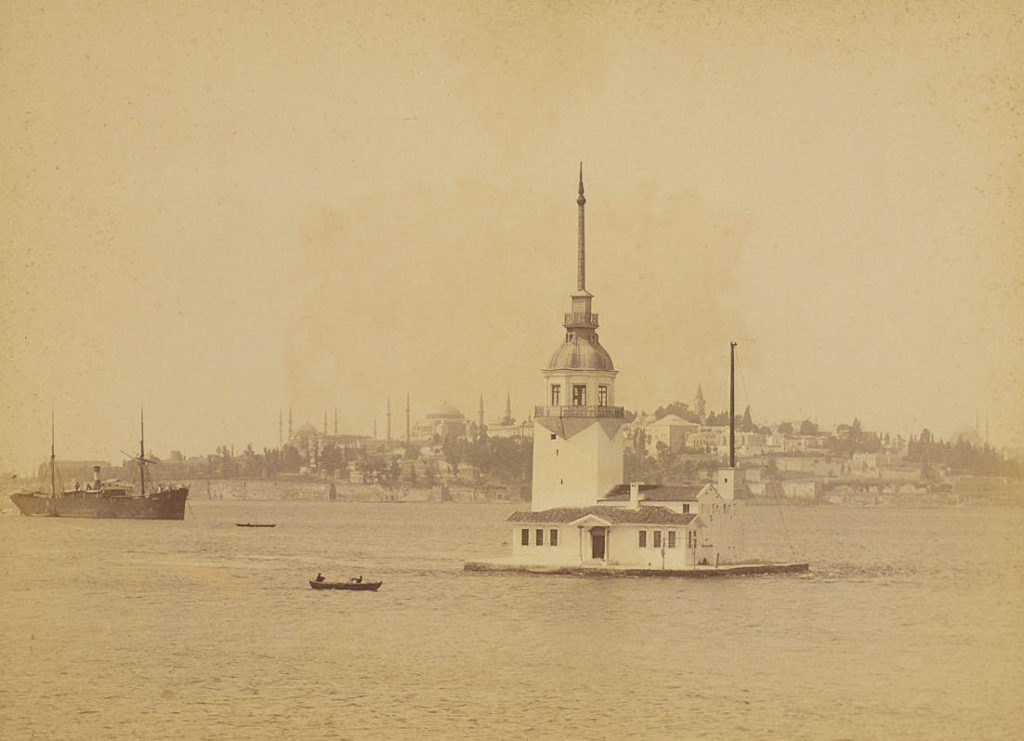
Coming back on the ferry we each had a drink, Turkish coffee served in dainty little cups & fruit juice for 1 Turkish lira & I smoked one of Mr. Fahri’s Turkish cigarettes. We saw a parade in the street led by a brass band, each section of marchers were wearing a different color but I couldn’t find out what it was about. There is a little tower with a cone shaped roof we can see from our little porch. It is called Leander’s Tower (he of the Hellesport which is not far from here) & we passed it quite closely on the ferry boat. All the streets of Istanbul are cobbled & very rough on cars which can make no speed. We had dinner in the Park Hotel. Our last lovely night view from our balcony & so to bed.
Thursday, May 20, 1953
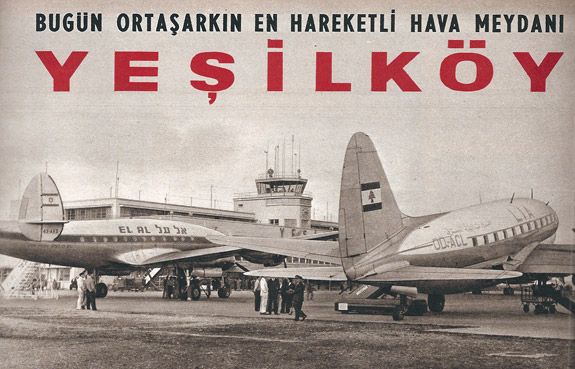
Up at 5 & on our way to Yesilkoy by 7:15. On our way to the airport we saw porters carrying huge baskets of artichokes, branches & all, they look like young trees. Everything is hustle & hustle. They start their day very early here in this city of hard work & money changers. Mr. Korham took us to the airport & we wait aboard at 8:45. Shortly after boarding the B.E.A. they served coffee & rolls. The trip to Athens was pleasant & the scenery interesting. We stopped here for about ½ hr. & after we started again, they served lunch, precisely the same menu they served when we came last Sun. One English Jewish couple we talked to on the plane had been to Israel & raved about it. We flew at an alt. of 20,000 ft. speed 300 m.p.h. On arriving at Rome Mr. Calllery came aboard to meet us & helped us to the Excelsior.
Thanks for reading “Traveling with Grace,”a series where we’re sharing (and annotating) posts from the travel diaries of Grace Amelia Hecht, native Baltimorean, b. 1897 and d. 1955. As mentioned in myintroductory posttranscription errors sometimes occur and I’ve made my best guesses where possible, denoted by [brackets]. – Rachel Kassman, marketing manager
